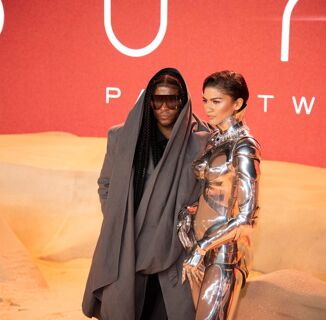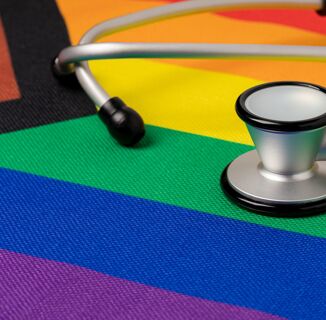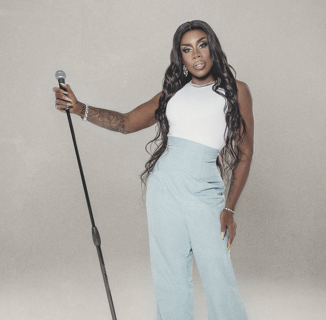Editor’s Note: This story has been updated to include Google News Initiative’s acknowledgement in a new tweet about the issue.
While enjoying time off for much of the last week, I thought that I could temporarily escape the constant rows, scandals and in-fighting that comes with reporting on LGBTQ+ issues. Boy, I couldn’t have been more wrong.
Over a week ago, a few different groups — most notably the Google News Initiative (GNI) — came together to form the “LGBTQIA+ Language and Media Literacy Program.” The program is the first phase of an initiative dubbed “The LGBTQ+ Learning Project” by VideoOut, a non-profit media hub for LGBTQ education.
Sounds like a great thing, right? At first, it sure seemed that way. Part of the program, which was published in Men’s Health Magazine on November 19, was a “LGBTQIA+ Glossary.” The introduction for the glossary noted, “We built the… Program to be more than a glossary, though at its simplest, it can function that way. It’s a way to understand the LGBTQIA+ community, and hopefully, it will transform the way journalists — and all of us — write and talk about LGBTQIA+ people.”
The introduction said that the terms included in the glossary — which they emphasize is not meant to be exhaustive — were based off of Google Trends data, and they chose to visualize how outdated or derogatory terms have faded in favor of different terms over the last few years. They touted it as a great end to Transgender Awareness Week, which was from November 13 to November 19.
As a journalist and media reporter constantly talking about the struggles others in journalism have with reporting on LGBTQ communities, this sounded like a welcome idea. Especially since — full disclosure coming — I had struggles with bringing LGBTQ+ community representation to Google initiatives in the past, I had high hopes for this project.
The fact that it came just days after the Local Media Foundation announced the creation of Word Is Out: The Queer Media Collaborative, which bought Google News Initiative-assisted funding to six LGBTQ media publications across the nation, gave me hope. It seemed, at a glance, that Google was stepping fully into “corporate ally” mode.
So it sounded like the glossary project to be one small step toward the right direction. Until I read this tweet from Karen Yin, author and founder of the Editors of Color group, among other things:
“This #LGBTQIA glossary looks slick—but where’s the B? Why wasn’t #bisexual (or #pansexual) included?” she asked.
This #LGBTQIA glossary looks slick—but where's the B? Why wasn't #bisexual (or #pansexual) included?
cc: @robynochs https://t.co/dhPuuaXF5N
— K. Yin 🎁 WHOLE WHALE: "A powerful message." (SLJ) (@KarenYin) November 24, 2021
Incredibly enough, as the glossary was put together by Google and VideoOut, and visual journalism studio Polygraph, then published in Men’s Health, none of the over 100 terms initially included were related to the multisexuality spectrum or even the word bisexual itself. Pansexual, Polysexual, omnisexual, mspec, all were terms somehow not included in the LG – B – TQIA+ glossary.
There were more issues I had as well, including the focus on many offensive terms in the glossary. Terms such as “Fag Hag,” “Maricón,” “Transvestite” and several similar derogatory slurs or words were defined, and while I recognize it is meant to be educational, it seems that more terms like these were included than terms that are actually acceptable to refer to LGBTQ+ people with.
I also don’t get how the data was formulated, but it’s very peculiar that every other letter in the LGBTQIA spectrum was represented in the terms included except the Bisexual+ portion, which is considered the majority of the community, yet is the same portion constantly erased or deemed confusing. Seems like a group that would be getting a lot of Google searches over, say, “Lip Sync” and “No fats, no femmes, no Asians.”
“We prioritized community voices and resources as we researched, but we present this glossary with the expectation that others will have different experiences and understandings of these terms,” the about page notes on the glossary.
Four different linguists were credited for their work on the glossary, and quick reviews and searches of the project show those at Video Out and Men’s Health that were involved in or touted the project upon its release. I decided they should see the concerns Yin and at this point, several other Bi+ people had expressed with the project: That they had been ignored and forgotten, and unfortunately common issue found with LGBTQ+ community representation.
Paging some people involved here in case they’re not aware: @DustinCanez @linguistpapi @lexicondk @DomACanning @queerterpreter @SpencerDukoff a lot of LGBTQ people have concerns about the glossary, especially bi+ people who are left out. Is there a way we can remedy this issue?
— Juwan the Writer+Expelled Bisexual🌈 (he/him) (@juwanthewriter) November 24, 2021
To the linguists’ credit, they dutifully responded and took responsibility for the failure. VideoOut also responded and acknowledged that the failure to include any terms representative of bi+ people. On other tweets, Men’s Health sex editor Jordyn Taylor would also acknowledge that the glossary needed to be revised.
They, rightfully so, received directed criticism for the project’s mistakes, although the linguists suggest they did not have direct say over every term that was chosen and included. One of them, Ártemis López, noted they were pansexual themselves and that they were thankful we bought it to their attention.
Hello! Thank you for bringing this up. We (the linguists) didn't have a ton to do with the original word list, though not including bi+ ppl is def huge oversight. My understanding is that this isn't meant to be the final final version of the glossary and more will be added. (1/2)
— dominique (@DomACanning) November 24, 2021
I just followed up via email with the organizers to see if we can get bi/pan added ASAP. We worked off of individual wordlists but as Dominique said this definitely should’ve been a priority.
— Doza (C. Mendoza) (@linguistpapi) November 24, 2021
And we really appreciate you bringing this to our attention! As mentioned, the linguists worked off of individual lists but we absolutely could have taken steps to review the entire document. I'm filing this as a lesson learned and will definitely do this in future projects. +
— e Ártemis López (elle/they) (@queerterpreter) November 24, 2021
As a pan person myself, which happens to be an identity constantly berated and intentionally erased in my country (Spain), I absolutely understand how this could be upsetting/disappointing/frustrating/much more. So thank you for tagging us in!
— e Ártemis López (elle/they) (@queerterpreter) November 24, 2021
This glossary will be expanded over time, however, I’m with you that bisexual—and pansexual—should have been in there at launch. They’ll be added shortly!
— Jordyn Taylor (@jordynhtaylor) November 27, 2021
Hi! I feel ya. Bi (and pan) should have been in there at launch, but I’ve been assured they’ll be added shortly as the glossary continues to expand.
— Jordyn Taylor (@jordynhtaylor) November 27, 2021
Hi all! We can’t see everyone’s tweets but we want to let you all know that we appreciate everyone’s contributions to make this resource better. There are terms that were intentionally left out due to the scope of work but other that were unintended omissions…
— VideoOut (@Video_Out) November 24, 2021
We are actively working behind the scenes to alleviate the unintended omissions. This resource is a living doc that we will be adding to and revising for many years to come. Please continue to alert us to opportunities for improvement. Much love! 💕
— VideoOut (@Video_Out) November 24, 2021
Curious enough, the main organization that the criticism was directed at, Google and GNI, did not respond or even acknowledge the issue with the project. They would only after the publication of this story.
That doesn’t surprise me — in 2020, I applied for the Google News Initiative Startups Lab, a program seeking to fund new or upcoming journalism publications that was supported by GNI. One of the initiatives I pitched, among others, was one that focused on journalism for bi+ people. Let’s just say I received a call shortly after submitting from someone involved in the project, not to talk about the idea further, but to let me know that said idea frankly “scared” some people (unnamed) during the application process. Needless to say, my ideas did not move forward in the program.
That’s not to say that any and everyone involved with Google, GNI, or even this glossary is a bad, biphobic person. It just seems to be a reoccurring theme that anything connected to Google not only does not accurately represent bi+ people, but that the people there go out of their way to avoid even acknowledging our existence and our voices consistently. Why? Good question that I can’t say on my own.
Unfortunately, the saga did not end here. While people working on the project presumably went to work on including the excluded people in the glossary, the issue quickly became a news item. As a journalist, that didn’t bother me, especially during a slow holiday news week. We have to do what we have to do.
What did bother me was the number of LGBTQ publications that wrote about it and did not include Karen Yin’s tweet, which was the first and only one to call the oversight out within the first few days of the project’s release, nor the concerns of several other bi+ advocates, including Robyn Ochs and Robert Brooks Cohen. They didn’t include the fact that I, a bisexual journalist, publicly requested a response from people involved in the project — but they made sure to include the answers that were made directly in response to me, without acknowledging me. They largely didn’t include any of the dozens of concerns from Bi+ people, and if they did, they included or credited white queer people.
I wasn’t focused on my own exclusion, although I always do my best to credit other journalists and publications’ work, especially in LGBTQ media. But it was disheartening to see publications — including some I’ve written for — center white and/or non-bisexual voices on an issue bought to the attention of many by bisexual people of color, which may be directly related to the fact that most of the coverage was written by white, non-bisexual journalists. I stopped counting at the number of instances this happened in at four.
Most important of all, this was a failure to accurately depict the story. For example, Xtra Magazine‘s story about the controversy features tweets from white people (at least four of six), including one that inaccurately depicts the publication that published the glossary as Men’s Fitness instead of Men’s Health. There’s also no direct referral to my question or the concerns bought by Yin, Ochs and others, but the answers in response to them were included.
Like many other bi+ people can tell you, this is not the first time Yin had called out such erasure before. An accurate story should reflect that.
Thanks, Juwan. @XtraMagazine, feel free to mention that I also persuaded @APStylebook to add entries for #bisexual and #asexual, which were excluded when #lesbian, #gay, #transgender, and #LGBT were added. https://t.co/6UihSoF339
— K. Yin 🎁 WHOLE WHALE: "A powerful message." (SLJ) (@KarenYin) November 25, 2021
Pink News similarly focused on white voices in their coverage, directly quoting a video producer named Travis Mannion first, although his and other’s tweets came long after Yin’s, who is also not mentioned here. None of the tweets they embedded in the story were from people of color — including Dominique Canning, one of the linguists who answered my concerns, which they direct linked for some reason instead of embedding like all the other tweets.
The Los Angeles Blade at least requested their own, independent comment from VideoOut executive director Jordan Reeves, and made no direct references to any of the people who voiced their concerns on social media.
“We left out some terms and phrases at launch — bisexual, for example — that should have been included from the very beginning!” Reeves said in a statement through a spokesperson, according to the Blade. “We are keenly aware of bi-erasure and the persistent confusion around bisexual identity. We are sorry we didn’t include it at luanch, [sic] but we are adding it (along with pansexual) very soon.”
UPDATE: Jordan Reeves, founder of @Video_Out and a partner in the initiative has apologised for 'bisexual' and 'pansexual’ not being part of the LGBT+ glossary at launch, but confirmed that they will be added soon.
— Openly 🏳️🌈 (@Openly) November 25, 2021
Yesterday, the glossary was quietly updated to include four new terms: “Bisexual,” “Bi erasure,” “Monosexism,” and “Pansexual.” The newly included definition for bisexual is long, but adequately states in part that it “refers to a person who has romantic, sexual, and/or emotional attraction toward more than one gender.” Bi erasure is defined as something that “can happen at the systemic level, where societal forces deny that bisexuality is real (see monosexism) or at the individual level, when a bisexual person’s identity is delegitimized.” They don’t directly refer to their own instance of bi erasure here, which I don’t blame them for.
The definition for pansexual starts out by stating it “refers to those attracted to people regardless of gender,” before saying it “sits under the umbrella term bisexual” and notes that “Bi Any Other Name, the seminal book on bisexual history, states that ‘pansexual people have been actively involved in the bisexual community since the 1970s.'”
Monosexism is defined as “the idea that everyone should be attracted to no more than one gender,” and as “an extension of heteronormativity,” but not as “derogatory” or “offensive,” like “homosexual” was. (They mistakenly wrote in a later tweet that the new term they defined was “monosexual.”)
While these terms are here now, other terms such as gender-fluid, two-spirit, poz or HIV-positive (while U=U is), and leather are still not included, among others. While yes, it’s not exhaustive, it’s educational value to some remains tenuous, considering these terms are considered important to some when discussing the LGBTQ+ community.
Still, Google nor GNI did not itself addressed any of the controversy or respond to requests from comment online and in publications. In tweets, an employee at Google, who is bisexual and identified herself as the Google Lead, said they’ve “DMed several people [and] privately and publicly apologized,” and that the failure to previously include these terms was a “mistake.” Because they have accused this writer and others of “opening them up to harassment” by criticizing their project, we are not naming them here. She declined to comment directly for this story or any further.
Shortly after, the GNI sent a tweet that read in part: “We’re so sorry for the error and appreciate all the feedback we have gotten.”
The glossary has been updated to include bisexual, pansexual, monosexual and bi erasure, which were mistakenly left out at launch. We're so sorry for the error and appreciate all the feedback we have gotten. https://t.co/HhBurfP3wa
— Google News Initiative (@GoogleNewsInit) November 30, 2021
After seven days of complaints, several news stories erasing many making those complaints, and then accusations that those complaints amount to support for harassment, the issue finally has a resolution. I’d like to thank everyone that put together this textbook-case instance of what bisexual community erasure looks like. An all around brand-spanking job of forgetting bi+ people, then addressing bi+ people only when they complain, and/or acting as if you haven’t heard or read anything from bi+ people ever before. Bravo.
In conclusion, here’s some of the perspectives that weren’t included in coverage of this controversy, which were largely from bi+ community leaders and bi+ people of color. This way, you can see first-hand what voices are not being valued or respected, even unfortunately within the LGBTQ community. Many of them also have still-outsanding questions for Google.
Huge fail. Wow. With bi+ people making up over 50% of the 2SLGBTQIA pie how did this even get approved? In addition to missing bisexual, also missing: our 2S and Indigiqueer siblings. Here's some more letters: WTF.
— Bi+ Arts Festival (@biartsfestival) November 25, 2021
Bisexuals decry this list as non-inclusive. Try again next yr. buh bye
— Steve (@blaqueword) November 24, 2021
— ACAB (@ghoulsNgoats) November 24, 2021
Everybody else has the bi/pan thing covered, so I'm gonna focus on encouraging you to add alt text to your images and gifs.
— Stormy 👻 (@thatstormygeek) November 25, 2021
"offensive terms like “homosexual”"…sorry? https://t.co/DRkyH6J7aM pic.twitter.com/vYhRBtBd16
— #1 Arashi Narukami Fan 👑 ♡ ★ 🔮🎮 (@T0YB0NNIE) November 26, 2021
Hey bis and pans, just a heads up that we've once again slipped into invisibility. Plan your day accordingly! https://t.co/RFbQomqap7
— ☀️ Sarah Sunsets🌙 (@CityGrownWillow) November 25, 2021
Since bi+ folks still aren't represented here 🤔 (despite comprising over half of the LGBTQ+ population), check out our website for more about our community and what it means to be bi+. https://t.co/IL4XnbZaNN https://t.co/2Wjo9PBQMg
— Bisexual Resource Center (@BRC_Central) November 27, 2021
This "lgbtq" glossary includes "Shawham/shawam (i.) is a type of interjection or exclamation credited to the Ballroom icon Jack Mizrahi aimed at hyping up a vogue performer as they count into a dip & slam their backs (land)," but not #bisexual or #pansexual. @GoogleNewsInit, WTF? https://t.co/Mshhok5AJM
— Robyn Ochs (@robynochs) November 24, 2021
At first I ignored this, rationalizing that they must have skipped the basics like gay, lesbian, bi, trans and instead focused on lesser-known terms… but then I looked and they define ALL of those except bisexual. It really feels like a parody, but it's not. https://t.co/KlrEBdo2Nd
— Robert Brooks Cohen (@RobertBCohen) November 26, 2021
Help make sure LGBTQ+ stories are being told...
We can't rely on mainstream media to tell our stories. That's why we don't lock our articles behind a paywall. Will you support our mission with a contribution today?
Cancel anytime · Proudly LGBTQ+ owned and operated
Read More in Culture
The Latest on INTO
Subscribe to get a twice-weekly dose of queer news, updates, and insights from the INTO team.
in Your Inbox














